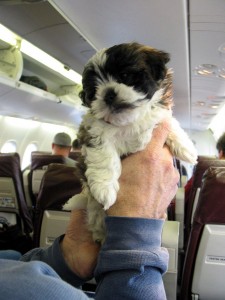Bringing your dog on an airplane with you could be a choice you make in order to experience more of life with your furry friend. Or, it may be a necessity. Either way, flying with a dog takes more preparation than jetting off solo, and the details that need to be addressed require careful consideration if you and your doggie companion (and others on the plane) want to have the most enjoyable and comfortable flight possible. Prepare your dog for an airplane ride ahead of time so that everyone will have a pleasant time to remember because you and your buddy will not have made a scene for anyone to remember. Fail to prepare your dog, who needs as much guidance through the ordeal as a child would, and things might not go as smoothly.
Flying with a dog is not as simple as bringing him or her onto the plane on a leash to sit in a seat next to you. It’s not as easy as carrying your little friend onboard to fly while on your lap. Different airlines have varying regulations about traveling with dogs and where they may be kept on a plane, so you will have to consider individual carrier rules as well as across the board federal restrictions (with some exceptions made for service dogs,) Know that most dogs will have to be put into a carrier while traveling. Getting your dog used to the travel carrier is just one of the steps you’ll need to take to attempt agreeable travel for all.
Decide Where Your Dog Will Fly
Depending on the size and weight of your dog, and the airline you fly on, you will need to prepare your dog for an airplane carrier or a crate as a form of shelter while flying. Most airlines only allow small dogs to fly in the cabin. These pups need to be placed in an approved carrier and tucked under the seat in front of the passenger, as is done with small carry-on baggage. Larger dogs must fly in the cargo hold area on most airlines. To be fair to the dog (and to meet airline requirements), he or she should be able to stand up while in the crate or carrier as a result of puppy crate training and should be able to turn around and lie down easily. With either type of temporary doggie home, it will require you to first acclimate your dog to the on-plane housing.
Prepare Your Dog for an Airplane Carrier or Crate
After you’ve picked appropriate in-the-air housing for your dog, which should be done weeks ahead of flight time to properly prepare your dog for flying, it’s time to help your dog practice entering into it and staying in it for a while (sometimes quite a while). Preparation for flying will mostly focus on getting your dog used to the carrier or crate, and spending increasing amounts of time inside it ideally up to the amount of hours you’ll be in the air or close to that timeframe. Small dogs who normally travel around in carriers sometimes get through this step more easily than large dogs.
Getting Ready for the Flight
Remember, your dog will not be motionless, as on the ground, while flying. He or she will experience take-off, possible turbulence, and landing. These aspects of air travel make it necessary for you to carry your dog around in the crate while practicing and preparing for a flight. It’s also important that you subject your dog to sounds that might occur on an aircraft, like conversations, children crying, engine noise (go for a ride in your car), and potentially other dogs. You should take your dog in and out of the carrier or crate about every day, or every other day, until the day of your flight. And, let him or her experience motion and noises about as often.
Time to Fly
By the day of your flight, your dog should be used to getting in and out of the carrier or crate (he or she will have to do this to go through security before boarding). Focus for flight day will be on limiting food and water so that your friend doesn’t need to use the bathroom often while in the air. Feed a bit of food and water (mostly ice chips), and pack potty pads with your doggie and in your carry-on bag. When you’re in the air, hopefully your dog can hold his bladder and bowels, but prepare yourself for a necessary trip to the largest bathroom you can find on the plane.
In addition to these steps, give lots of love on the plane, let your pup rest as much as he or she wants, and enjoy your trip together.
As with all human-dog interactions, how to prepare your dog for an airplane comes down to love first. Then, understanding. Dogs are amazing animals and they can learn new tasks quickly, and adapt to many situations. But, they’re dogs and they’re not used to human experiences. We need to guide them gently and hope for the best outcome, if we want them to tag along with us in our day-to-day lives so that we can be the ideal caregivers for them.
When people call me asking about dog obedience training for airplane travel, I politely tell them that I can help them prepare their dog for flying, but I will not require a dog to be obedient. Open to human experiences as much as can be expected, sure. But, not subservient. To learn more about how I facilitate successful relationships between humans and dogs (I am much more than just a private dog trainer), feel free to give me a call or reach out to me on my contact page.

